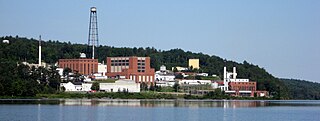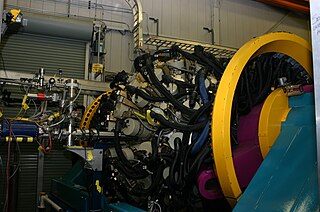
Mass spectrometry (MS) is an analytical technique that ionizes chemical species and sorts the ions based on their mass-to-charge ratio. In simpler terms, a mass spectrum measures the masses within a sample. Mass spectrometry is used in many different fields and is applied to pure samples as well as complex mixtures.

The National Superconducting Cyclotron Laboratory (NSCL) is located on the campus of Michigan State University and is the leading rare isotope research facility in the United States. Established in 1963, the cyclotron laboratory is the nation’s largest nuclear science facility on a university campus. Funded primarily by the National Science Foundation and MSU, the NSCL operates two superconducting cyclotrons. The lab’s scientists investigate the properties of rare isotopes and nuclear reactions. In nature, these reactions would take place in stars and exploding stellar environments such as novae and supernovae. The K1200 cyclotron is the highest-energy continuous beam accelerator in the world.
CPT or Cpt may stand for:

A Penning trap is a device for the storage of charged particles using a homogeneous axial magnetic field and an inhomogeneous quadrupole electric field. This kind of trap is particularly well suited to precision measurements of properties of ions and stable subatomic particles. Geonium atoms have been created and studied this way, to measure the electron magnetic moment. Recently these traps have been used in the physical realization of quantum computation and quantum information processing by trapping qubits. Penning traps are used in many laboratories worldwide, including CERN, to store antimatter like antiprotons.

TRIUMF is Canada's national particle accelerator centre. It is considered Canada's premier physics laboratory, and is consistently regarded as one of the leading subatomic physics research centers on the international level. Owned and operated by a consortium of universities as a joint venture, TRIUMF is located on the south campus of one of its founding members – the University of British Columbia in Vancouver, British Columbia. TRIUMF houses the world's largest cyclotron, a source of 520 MeV protons, which was named an IEEE Milestone in 2010. TRIUMF's accelerator-focused activities involve particle physics, nuclear physics, nuclear medicine, materials science, and detector and accelerator development.

Accelerator mass spectrometry (AMS) is a form of mass spectrometry that accelerates ions to extraordinarily high kinetic energies before mass analysis. The special strength of AMS among the mass spectrometric methods is its power to separate a rare isotope from an abundant neighboring mass. The method suppresses molecular isobars completely and in many cases can separate atomic isobars also. This makes possible the detection of naturally occurring, long-lived radio-isotopes such as 10Be, 36Cl, 26Al and 14C. Their typical isotopic abundance ranges from 10−12 to 10−18. AMS can outperform the competing technique of decay counting for all isotopes where the half-life is long enough.

An ion trap is a combination of electric or magnetic fields used to capture charged particles, often in a system isolated from an external environment. Ion traps have a number of scientific uses such as mass spectrometry, basic physics research, and controlling quantum states. The two most common types of ion trap are the Penning trap, which forms a potential via a combination of electric and magnetic fields, and the Paul trap which forms a potential via a combination of static and oscillating electric fields.
Fourier-transform ion cyclotron resonance mass spectrometry is a type of mass analyzer for determining the mass-to-charge ratio (m/z) of ions based on the cyclotron frequency of the ions in a fixed magnetic field. The ions are trapped in a Penning trap, where they are excited to a larger cyclotron radius by an oscillating electric field orthogonal to the magnetic field. After the excitation field is removed, the ions are rotating at their cyclotron frequency in phase. These ions induce a charge on a pair of electrodes as the packets of ions pass close to them. The resulting signal is called a free induction decay (FID), transient or interferogram that consists of a superposition of sine waves. The useful signal is extracted from this data by performing a Fourier transform to give a mass spectrum.

Isotope-ratio mass spectrometry (IRMS) is a specialization of mass spectrometry, in which mass spectrometric methods are used to measure the relative abundance of isotopes in a given sample.
ISOLTRAP is a tandem Penning trap mass spectrometer at the On-Line Isotope Mass Separator at CERN. The facility plays a leading role in the field of high precision mass spectrometry of radioactive ions. The masses of more than 200 short-lived nuclides have been measured with a relative uncertainty of typically dm/m ~ 1x10−7 and even almost up to one order of magnitude lower in some special cases.
Heinz-Jürgen Kluge, known as Jürgen Kluge, is a physicist probably best known for the development of ion-storage devices and methods for accurate measurements of nuclear masses.
A radio-frequency quadrupole (RFQ) beam cooler is a device for particle beam cooling, especially suited for ion beams. It lowers the temperature of a particle beam by reducing its energy dispersion and emittance, effectively increasing its brightness (brilliance). The prevalent mechanism for cooling in this case is buffer-gas cooling, whereby the beam loses energy from collisions with a light, neutral and inert gas. The cooling must take place within a confining field in order to counteract the thermal diffusion that results from the ion-atom collisions.
Tandem Accelerator Superconducting Cyclotron (TASCC) was an accelerator facility constructed at Chalk River Laboratories on October 3, 1986. TASCC was the world's first Tandem Accelerator and able to accelerate most elements to 10 MeV per nucleon. The TASCC facility was decommissioned beginning in 1996.

A particle accelerator is a machine that uses electromagnetic fields to propel charged particles to very high speeds and energies, and to contain them in well-defined beams.
The helical orbit spectrometer (HELIOS) is a measurement device for studying nuclear reactions in inverse kinematics. It is installed at the ATLAS facility at Argonne National Laboratory.
The André E. Lalonde Accelerator Mass Spectrometry Laboratory is a accelerator mass spectrometry research facility at the University of Ottawa in Canada. It is currently the only facility of its type in Canada. It is named after former University of Ottawa Faculty of Science dean André E. Lalonde, who died of cancer in 2012.

RAON is a South Korean particle physics laboratory within the Rare Isotope Science Project (RISP) that is being constructed in the outskirts of Daejeon neighboring Sejong, South Korea by the Institute for Basic Science (IBS). It is expected to be finished by 2021.
Atom Trap Trace Analysis (ATTA) is an extremely sensitive trace analysis method developed by Argonne National Lab (ANL). ATTA is used on long-lived, stable radioisotopes such as 81Kr, 85Kr, and 39Ar. By using a laser that is locked to an atomic transition, a CCD or PMT will detect the laser induced fluorescence to allow highly selective, parts-per-trillion to parts-per-quadrillion concentration measurement with single atom detection. This method is useful for atomic transport processes, such as in the atmosphere, geological dating, as well as noble gas purification.















